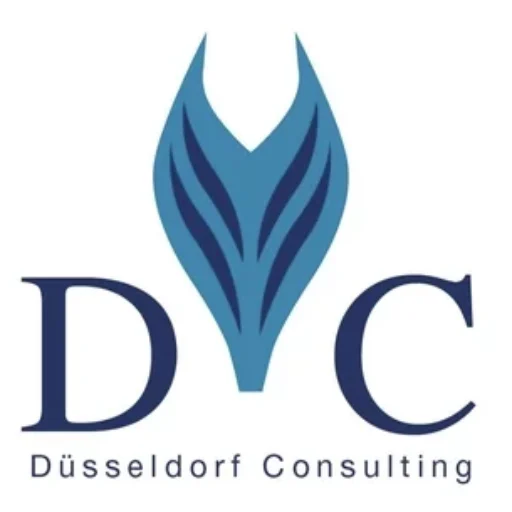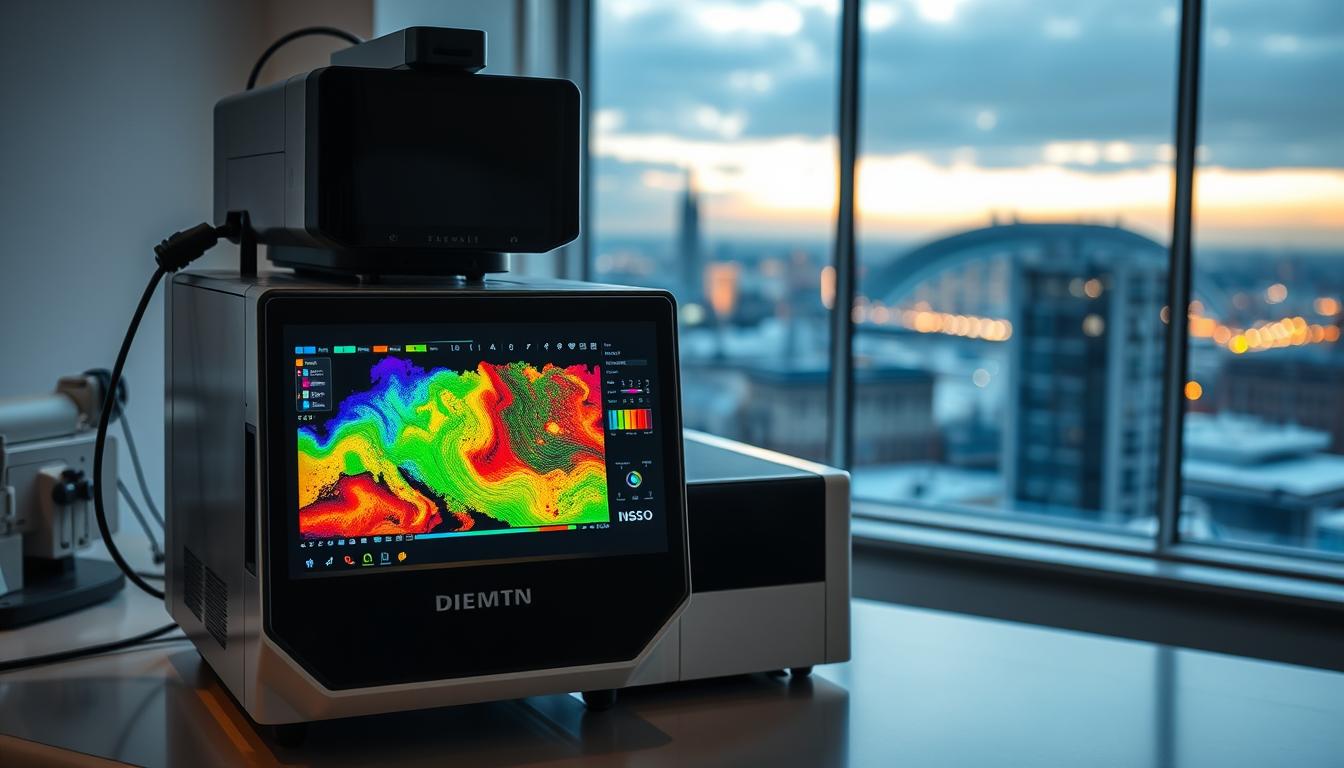Hyperspectral imaging technology has emerged as a powerful tool in various applications, including military, environmental, and civil uses.
Düsseldorf Consulting GmbH, located at Königsallee 22, 40212 Düsseldorf, is a leading expert in the field, providing valuable insights and guidance on German hyperspectral imaging technology.
The significance of hyperspectral imaging systems is growing rapidly across different sectors, and understanding their capabilities is crucial for leveraging their potential.
Key Takeaways
- Hyperspectral imaging technology has various applications.
- Düsseldorf Consulting GmbH is a leading expert in the field.
- The technology is gaining importance in Germany.
- Understanding hyperspectral imaging systems is crucial.
- Their applications span across multiple sectors.
Overview of Hyperspectral Imaging Systems
Advanced hyperspectral imaging solutions are being increasingly adopted in Germany for their ability to provide detailed spectral information across various industries. Hyperspectral imaging combines spectroscopy and imaging to generate a three-dimensional database of spectral and spatial information.
Definition and Principles of Hyperspectral Imaging
Hyperspectral imaging is a technology that captures detailed spectral information from a wide range of electromagnetic spectrum, far beyond what the human eye can see. It involves capturing images across numerous spectral bands, often hundreds, allowing for the identification of materials and their properties with high precision.
The principle behind hyperspectral imaging is based on the concept that different materials reflect and absorb light in unique ways, creating a spectral signature that can be used to identify and analyze the composition of objects or scenes. This technology has been instrumental in advancing various fields, including agriculture, environmental monitoring, and medical diagnostics.
Applications in Various Industries
Hyperspectral imaging has a wide range of applications across different industries. In agriculture, it is used for crop monitoring, detecting stress factors such as disease, drought, or nutrient deficiencies. Environmental monitoring benefits from hyperspectral imaging through the detection of changes in vegetation health, tracking of pollutants, and analysis of water quality.
In the medical field, hyperspectral imaging is being explored for diagnostic purposes, such as identifying cancerous tissues during surgery. The technology’s ability to provide detailed spectral information makes it a valuable tool for research and diagnostics.
| Industry | Application | Benefits |
|---|---|---|
| Agriculture | Crop Monitoring | Early detection of stress factors, improved crop yields |
| Environmental Monitoring | Vegetation Health, Pollution Tracking | Effective monitoring and management of environmental resources |
| Medical Diagnostics | Cancer Detection | Enhanced diagnostic accuracy, improved patient outcomes |
Advantages Over Conventional Imaging Techniques
Hyperspectral imaging offers several advantages over conventional imaging techniques. Its ability to capture detailed spectral information allows for more accurate identification and analysis of materials and their properties. This is particularly beneficial in applications where subtle differences in spectral signatures are critical.
Key advantages include:
- Enhanced diagnostic accuracy
- Ability to detect subtle changes in material properties
- Non-destructive analysis
By leveraging these advantages, hyperspectral imaging is poised to continue making significant impacts across various industries in Germany, driven by advancements in hyperspectral camera equipment and advanced hyperspectral imaging solutions.
Key Players in the German Market
The German hyperspectral imaging market is witnessing significant growth, driven by key players who are innovating and expanding their offerings. This growth is fueled by advancements in technology and increasing demand across various industries.
Major Companies in Hyperspectral Imaging
Several major companies are leading the hyperspectral imaging industry in Germany. These companies are providing top hyperspectral imaging solutions that cater to diverse needs, from precision agriculture to environmental monitoring.
Some of the notable companies include those specializing in sensor technology, data analysis software, and system integration. Their innovations are making hyperspectral imaging more accessible and effective for various applications.
Innovations from Düsseldorf Consulting GmbH
Düsseldorf Consulting GmbH is a key player in the German hyperspectral imaging market, offering innovative solutions and expertise. Their work in hyperspectral imaging technology for precision agriculture has been particularly impactful, enabling more efficient crop monitoring and management.
According to industry experts, “The integration of hyperspectral imaging with precision agriculture is revolutionizing the way we approach crop management.”
“Hyperspectral imaging allows for the detailed analysis of crop health, enabling farmers to make data-driven decisions.”
Düsseldorf Consulting GmbH’s contributions can be seen in their collaborative projects, which aim to advance the use of hyperspectral imaging in various sectors. For more information on their innovative solutions, visit their website at Düsseldorf Consulting GmbH.
Collaborations and Partnerships in Germany
Collaborations and partnerships are crucial in the hyperspectral imaging industry, driving innovation and adoption. In Germany, companies, research institutions, and government bodies are working together to advance hyperspectral imaging technology.
- Research collaborations to improve sensor technology and data analysis algorithms.
- Partnerships between companies to integrate hyperspectral imaging with other technologies like AI and IoT.
- Government initiatives to support the adoption of hyperspectral imaging in environmental monitoring and agriculture.
These collaborations are expected to drive the growth of the hyperspectral imaging market in Germany, making it a hub for top hyperspectral imaging solutions and innovation.
Industries Benefiting from Hyperspectral Imaging
Hyperspectral imaging technology is transforming various industries in Germany with its advanced applications. The technology’s ability to capture detailed spectral information is opening new avenues in multiple sectors.
Agriculture and Crop Monitoring
In agriculture, hyperspectral imaging is being utilized for precision farming. It enables farmers to monitor crop health, detect early signs of stress, and optimize irrigation and fertilizer application. This technology is particularly beneficial for crop monitoring, allowing for early intervention and potentially increasing yields.
The use of hyperspectral imaging in agriculture also facilitates the identification of specific crop characteristics, such as moisture content and nutrient levels. This information can be crucial for making informed decisions regarding crop management.
Environmental Monitoring and Management
Hyperspectral imaging is also making significant contributions to environmental monitoring and management. It can be used to track changes in vegetation health, monitor water quality, and detect environmental pollutants. This capability is essential for maintaining ecological balance and ensuring compliance with environmental regulations.
Furthermore, hyperspectral imaging aids in the assessment of land use changes and their impacts on the environment. By analyzing hyperspectral data, researchers can gain insights into the effects of human activities on ecosystems.
Medical Diagnostics and Research
In the medical field, hyperspectral imaging is being explored for its potential in diagnostics and research. It can provide detailed information about tissue composition and pathology, aiding in the early detection of diseases. Researchers are investigating its applications in various medical specialties, including oncology and dermatology.
The technology’s ability to analyze spectral signatures of tissues and cells could lead to advancements in medical diagnostics, potentially improving patient outcomes.
Technological Advancements in Hyperspectral Imaging
Hyperspectral imaging technology has made substantial progress in Germany, driven by advancements in sensors and software. The country is witnessing a significant transformation in the field, with various innovations enhancing the capabilities and applications of hyperspectral imaging.
Latest Developments in Sensors and Equipment
Recent advancements in hyperspectral camera equipment in Germany have led to improved resolution and sensitivity. These developments have enabled more accurate data collection across various industries, including agriculture and environmental monitoring.
According to a study published on PMC, advancements in sensor technology have significantly contributed to the growth of hyperspectral imaging applications.
Key advancements in sensor technology include:
- Enhanced spectral resolution
- Increased sensitivity to detect subtle changes
- Improved durability for field applications
Software Innovations for Data Analysis
Software innovations have played a crucial role in advancing hyperspectral imaging in Germany. Advanced data analysis software enables researchers to interpret complex data sets more efficiently, leading to actionable insights.
These software solutions have become indispensable in various sectors, including medical diagnostics and environmental monitoring. The ability to analyze large datasets quickly and accurately has opened new avenues for research and application.
“The integration of advanced software with hyperspectral imaging has revolutionized data analysis, enabling more precise and timely decision-making.” – Expert in Hyperspectral Imaging
Integration with AI and Machine Learning
The integration of AI and machine learning with hyperspectral imaging is a significant trend in Germany. This convergence of technologies enhances the analytical capabilities of hyperspectral imaging, allowing for more sophisticated data interpretation.
| Technology | Application | Benefit |
|---|---|---|
| AI Integration | Enhanced data analysis | Improved accuracy |
| Machine Learning | Pattern recognition | Predictive insights |
| Hyperspectral Imaging | Detailed spectral data | Comprehensive analysis |
The future of hyperspectral imaging in Germany looks promising, with continued advancements expected in sensors, software, and AI integration. These developments will further expand the applications and capabilities of hyperspectral imaging technology.
Regulatory and Compliance Standards
The regulatory environment for hyperspectral imaging in Germany is multifaceted, involving various European and national regulations. Companies operating in this sector must navigate these regulations to ensure compliance and successful market entry.
European Regulations Impacting Hyperspectral Imaging
European regulations play a significant role in shaping the hyperspectral imaging industry in Germany. Key regulations include:
- The EU’s Medical Device Regulation (MDR) for hyperspectral imaging applications in medical diagnostics.
- The General Data Protection Regulation (GDPR) for handling data collected through hyperspectral imaging.
- Environmental regulations such as the EU’s Waste Electrical and Electronic Equipment (WEEE) directive.
These regulations impact how hyperspectral imaging technology is developed, marketed, and used across different industries in Germany.
Certification and Testing Bodies in Germany
In Germany, several bodies are responsible for the certification and testing of hyperspectral imaging systems. These include:
| Certification Body | Role |
|---|---|
| TÜV Rheinland | Provides testing and certification services for hyperspectral imaging systems, ensuring compliance with EU and national standards. |
| DEKRA | Offers certification and testing for hyperspectral imaging technology, focusing on safety and performance standards. |
| Federal Institute for Materials Research and Testing (BAM) | Involved in the testing and certification of materials and technologies, including those related to hyperspectral imaging. |
Importance of Compliance for Businesses
Compliance with regulatory standards is crucial for businesses operating in the hyperspectral imaging sector in Germany. Non-compliance can result in significant fines, legal action, and damage to a company’s reputation. Moreover, compliance ensures that products are safe, reliable, and perform as intended, which is vital for maintaining customer trust and achieving market success.
For companies based at prestigious locations like Königsallee 22, 40212 Düsseldorf, understanding and adhering to these regulations is key to their success in the German market.
Market Trends and Growth Projections
Driven by advancements in technology and rising demand for environmental monitoring, the hyperspectral imaging sector is expanding rapidly. This growth is evident in various industries, including precision agriculture, where hyperspectral imaging technology is being increasingly adopted for crop monitoring and yield optimization.

Current Market Size and Growth Rates
The current market size for hyperspectral imaging in Germany is substantial, with a growth rate that is expected to continue in the coming years. According to recent reports, the market is driven by the increasing demand for precision agriculture and environmental monitoring solutions. The benefits of hyperspectral imaging technology, such as enhanced crop yield analysis and detailed environmental monitoring, are key factors contributing to this growth.
Future Trends in Hyperspectral Imaging
Future trends in hyperspectral imaging include the integration of Artificial Intelligence (AI) and Machine Learning (ML) algorithms for enhanced data analysis. This integration is expected to revolutionize the field by providing more accurate and actionable insights. Additionally, advancements in sensor technology will further expand the applications of hyperspectral imaging.
Impact of COVID-19 on the Industry
The COVID-19 pandemic has had a mixed impact on the hyperspectral imaging industry. While some sectors, such as medical diagnostics, saw an increase in demand, others faced disruptions due to supply chain constraints. However, the pandemic has also accelerated the adoption of remote monitoring technologies, including hyperspectral imaging, for environmental and agricultural applications.
The top hyperspectral imaging companies in Germany are at the forefront of this technological advancement, driving innovation and adoption across various sectors. As the market continues to grow, businesses operating in this sector are poised to benefit from the increasing demand for hyperspectral imaging solutions.
Hyperspectral Imaging Applications in Research
The application of hyperspectral imaging in research settings across Germany is yielding significant breakthroughs. Hyperspectral imaging technology is being utilized in various research fields, enhancing data collection and analysis. This advanced imaging technique is providing researchers with detailed spectral information, enabling new insights into complex phenomena.
Academic Institutions Leading Research Efforts
Several academic institutions in Germany are at the forefront of hyperspectral imaging research. These institutions are conducting cutting-edge studies in fields such as environmental monitoring, medical diagnostics, and agricultural research. For instance, the University of Munich is using hyperspectral imaging to analyze crop health and optimize agricultural practices.
The University of Heidelberg is another prominent institution leveraging hyperspectral imaging for medical research, exploring its potential for early disease detection and diagnosis. These institutions are not only advancing the technology but also contributing to the scientific community through their research findings.
Case Studies Demonstrating Hyperspectral Imaging
Numerous case studies have demonstrated the effectiveness of hyperspectral imaging in various research applications. For example, a study conducted by the German Aerospace Center used hyperspectral imaging to monitor environmental changes, such as deforestation and water pollution. The results provided valuable insights into the impact of human activities on the environment.
In the medical field, hyperspectral imaging has been used to detect skin cancer at an early stage. Researchers at the University Hospital in Berlin have successfully applied this technology to differentiate between benign and malignant skin lesions, improving diagnostic accuracy.
Contributions to Scientific Knowledge
The contributions of hyperspectral imaging to scientific knowledge are substantial. By providing detailed spectral information, this technology is enabling researchers to gain a deeper understanding of complex phenomena. The data collected through hyperspectral imaging is being used to develop new theories, models, and applications across various disciplines.
Furthermore, the integration of hyperspectral imaging with other technologies, such as artificial intelligence and machine learning, is opening new avenues for research. This synergy is expected to drive significant advancements in the coming years, further expanding the boundaries of scientific knowledge.
Challenges Facing the Hyperspectral Imaging Industry
Despite its potential, the hyperspectral imaging technology sector encounters numerous obstacles. The industry’s growth in Germany is hindered by several key challenges that need to be addressed for it to reach its full potential.
Technical Limitations and Solutions
One of the primary challenges facing the hyperspectral imaging industry is technical limitations. Hyperspectral Imaging Systems in Germany require sophisticated technology to capture and analyze the vast amounts of data they generate. However, current systems often suffer from limitations in spectral resolution, spatial resolution, and data processing capabilities.
To overcome these technical challenges, companies are investing heavily in research and development. Innovations in sensor technology, data analytics software, and machine learning algorithms are being explored to enhance the capabilities of hyperspectral imaging systems. For instance, advancements in German hyperspectral imaging technology are focusing on improving the spectral resolution and reducing the noise in the data captured.
Market Entry Barriers for New Companies
Another significant challenge is the high barrier to entry for new companies. The development of Hyperspectral imaging technology for precision agriculture and other applications requires substantial investment in technology, talent, and testing. New entrants must compete with established players who have already overcome initial technical and market challenges.
To mitigate these barriers, new companies are forming strategic partnerships with existing industry players, research institutions, and government bodies. These collaborations can provide access to necessary resources, expertise, and market networks, helping new entrants to establish themselves in the market.
Data Management Challenges
The vast amounts of data generated by hyperspectral imaging systems pose significant data management challenges. The industry needs advanced data processing and analytics capabilities to extract meaningful insights from the data. This requires not only sophisticated software but also skilled personnel who can interpret the data correctly.
To address these challenges, companies are developing more advanced data analytics tools and training programs for personnel. The integration of AI and machine learning is also being explored to improve data processing efficiency and accuracy.
Funding and Investment Opportunities
Funding opportunities for hyperspectral imaging technologies in Germany are on the rise, driven by the country’s strong emphasis on innovation and technological advancement. This growth is supported by various government initiatives and private investments.
Government Grants and Initiatives in Germany
The German government has launched several programs to support the development and application of hyperspectral imaging technologies. These include grants for research and development projects, as well as initiatives to promote the adoption of hyperspectral imaging in various industries.
Key Programs and Initiatives:
- Research funding programs by the Federal Ministry of Education and Research (BMBF)
- Initiatives by the German Aerospace Center (DLR) for hyperspectral imaging applications
- Support for small and medium-sized enterprises (SMEs) through the Federal Ministry for Economic Affairs and Energy (BMWi)

Investment Trends in Hyperspectral Technologies
Investment in hyperspectral imaging technologies is increasing, driven by the technology’s potential to transform various sectors, including agriculture, environmental monitoring, and healthcare. Investors are recognizing the benefits of hyperspectral imaging, such as enhanced data accuracy and the ability to make more informed decisions.
Recent Trends:
- Increased venture capital investment in startups developing hyperspectral imaging solutions
- Growing interest from private equity firms in companies with established hyperspectral imaging technologies
- Rising investment in infrastructure to support the development and deployment of hyperspectral imaging systems
Role of Private Equity in the Sector
Private equity plays a significant role in the hyperspectral imaging sector, providing necessary funding for companies to scale their operations and develop new technologies. Private equity firms are attracted to the sector due to its potential for high returns on investment and the opportunity to support innovative technologies.
Benefits of Private Equity Investment:
- Access to capital for growth and expansion
- Strategic guidance and support from experienced investors
- Opportunities for collaboration and partnerships within the industry
Future Outlook for Hyperspectral Imaging in Germany
The future of hyperspectral imaging in Germany is poised for significant growth, driven by advancements in technology and increasing demand across various industries. As the technology continues to mature, we can expect to see widespread adoption in sectors such as agriculture, environmental monitoring, and medical diagnostics.
Predictions for Industry Growth
Industry experts predict that the hyperspectral imaging market in Germany will experience substantial growth over the next few years. This growth will be driven by the increasing need for advanced imaging solutions that can provide detailed spectral information. Advanced hyperspectral imaging solutions are expected to play a crucial role in this growth, enabling businesses to make more informed decisions.
The demand for hyperspectral camera equipment is also expected to rise, driven by the need for high-quality imaging data. Companies such as Düsseldorf Consulting GmbH are likely to be at the forefront of this trend, providing innovative solutions and expertise to businesses across Germany.
Emerging Technologies to Watch
Several emerging technologies are set to shape the future of hyperspectral imaging in Germany. These include advancements in sensor technology, improvements in data analysis software, and the integration of hyperspectral imaging with other technologies such as AI and machine learning. Hyperspectral Imaging Systems that incorporate these emerging technologies are expected to offer enhanced capabilities and improved performance.
- Advancements in sensor technology
- Improvements in data analysis software
- Integration with AI and machine learning
The Role of Düsseldorf Consulting GmbH in Development
Düsseldorf Consulting GmbH, located at Königsallee 22, 40212 Düsseldorf, is expected to play a significant role in the development of the hyperspectral imaging industry in Germany. With its expertise in consulting and innovation, the company is well-positioned to support businesses looking to adopt hyperspectral imaging technologies.
The company’s role in promoting the adoption of hyperspectral imaging technologies will be crucial in driving industry growth. By providing advanced hyperspectral imaging solutions and supporting businesses in their adoption journey, Düsseldorf Consulting GmbH is set to be a key player in the future of hyperspectral imaging in Germany.
Conclusion: The Significance of Hyperspectral Imaging in Germany
Hyperspectral imaging technology has emerged as a vital tool in various industries, including precision agriculture and environmental monitoring, in Germany. The benefits of hyperspectral imaging technology are being increasingly recognized, driving its adoption across different sectors.
Key Takeaways
The applications of hyperspectral imaging in Germany are diverse, ranging from precision agriculture to medical diagnostics. Its ability to provide detailed spectral information makes it an invaluable asset for industries seeking to enhance their operations.
Opportunities for Businesses
Businesses in Germany interested in hyperspectral imaging technology can leverage its potential by exploring its applications in their respective fields. The technology’s benefits, including improved accuracy and efficiency, make it an attractive solution for companies looking to innovate.
As hyperspectral imaging continues to evolve, its significance in Germany is expected to grow, driven by advancements in technology and increasing demand from various industries. Hyperspectral imaging applications in Germany will likely expand, contributing to the country’s technological progress.




